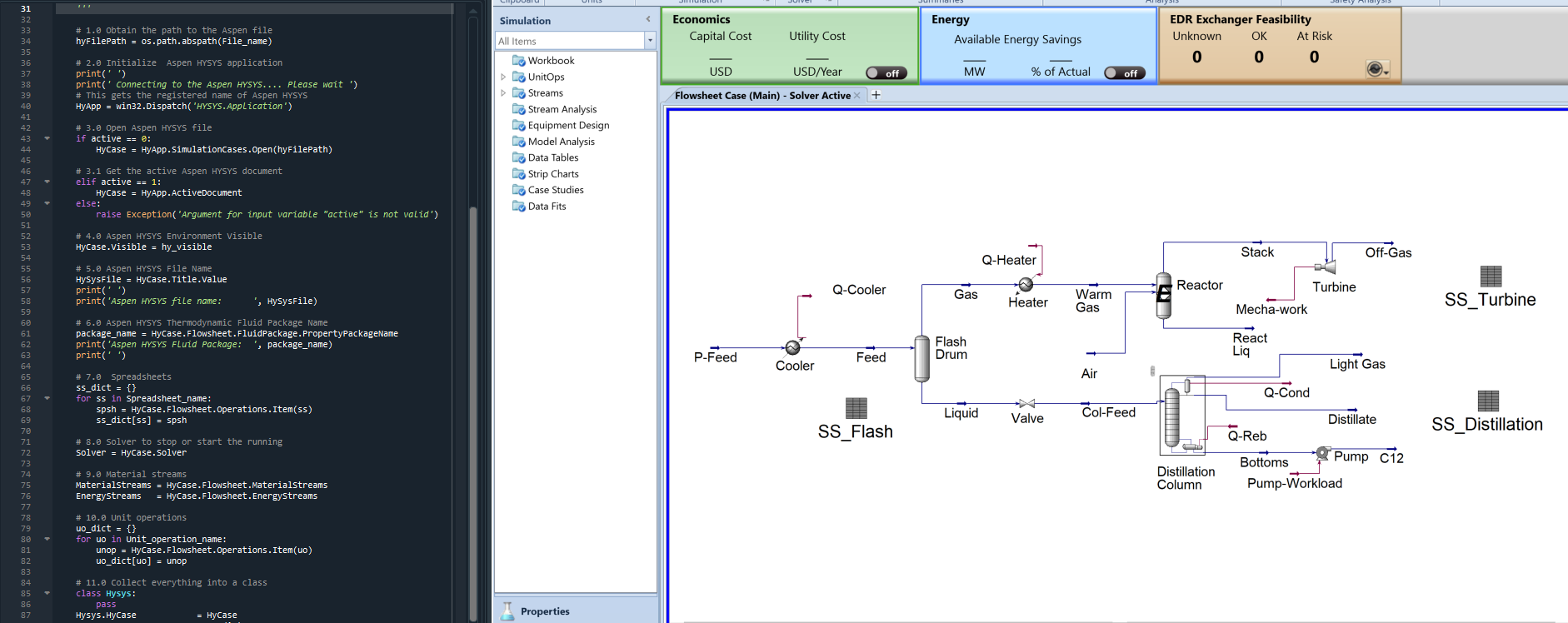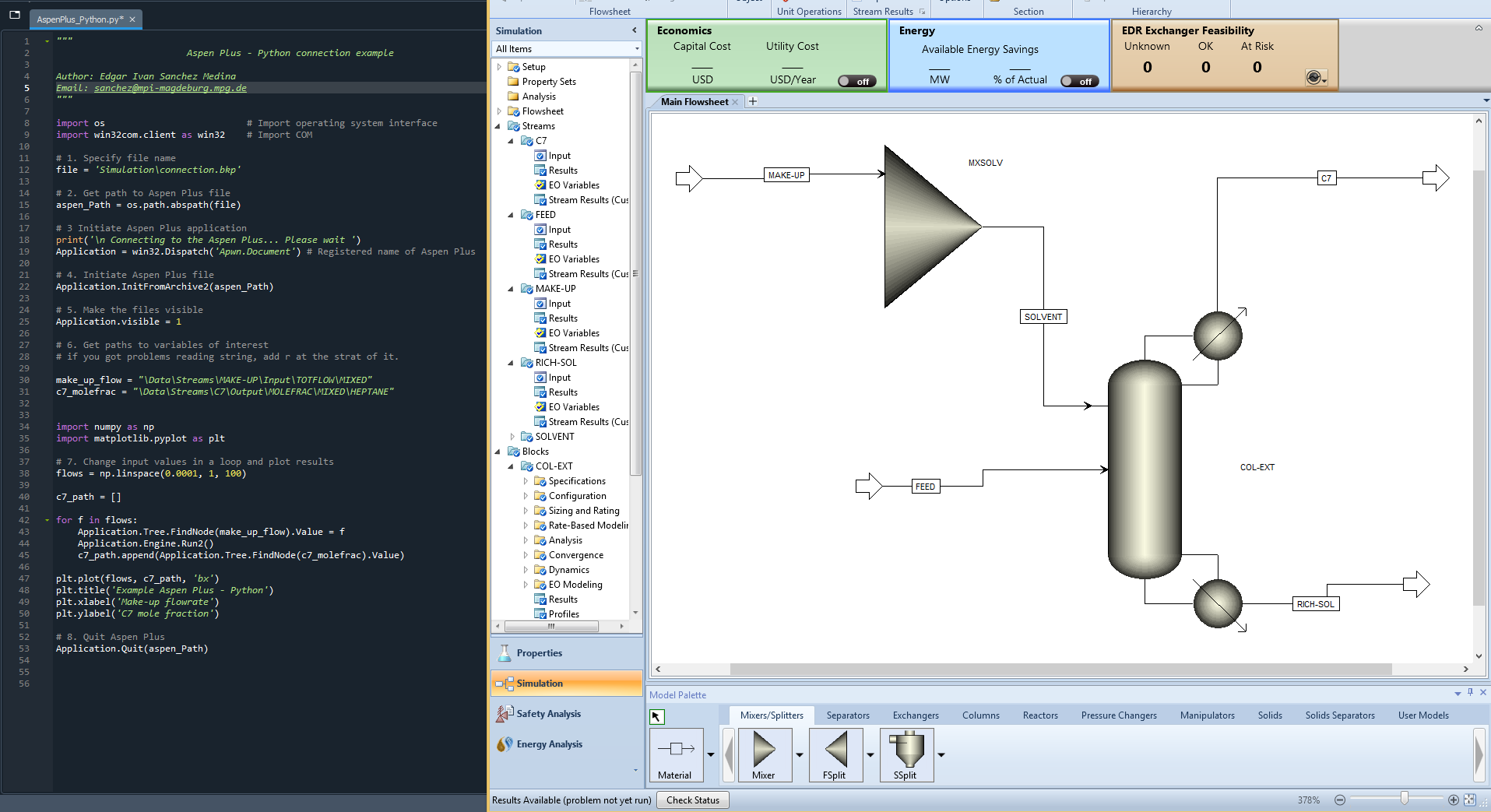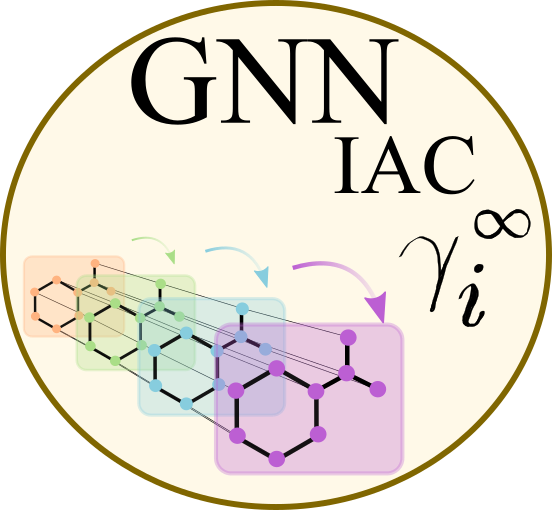Collection of functions to test optimization algorithms
Published:
A collection of continous functions (coded in Python) with known minimum to test optimization algorithms.
Published:
A collection of continous functions (coded in Python) with known minimum to test optimization algorithms.
Published:
Several stochastic optimization methods (coded in Python) for derivative-free optimization of functions of n-dimensions.

Published:
A pedagogical implementation (as .ipynb) of optimization algorithms used to trained ML models.
Published:
An Aspen HYSYS-Python connection using spreadsheets.

Published:
An Aspen Plus-Python connection using object paths.

Published:
A GNN model that predicts isothermal infinite dilution activity coefficients.

Published:
A hybrid GNN model that predicts infinite dilution activity coefficients at varying temperatures.

Published:
A JupyterBook for the hands-on part of a Machine Learning in Chemical Engineering introductory course.

Published in Computer Aided Chemical Engineering, 2018
In this paper we study the effect of the initial state of a ternary semi-continous distillation system on its periodic orbit.
Recommended citation: Madabhushi, P.B., Medina, E.I.S. and Adams II, T.A., 2018. Understanding the dynamic behaviour of semicontinuous distillation. In Computer Aided Chemical Engineering (Vol. 43, pp. 845-850). Elsevier. https://doi.org/10.1016/B978-0-444-64235-6.50148-0
Published in Environmental Science: Water Research & Technology, 2019
Here, we investigate the effects of three widely used antiscalants (NTMP, EDTMP and DTPMP) on the precipitation of calcium from solutions under chemical conditions relevant to brackish desalination brine.
Recommended citation: Jain, T., Sanchez, E., Owens-Bennett, E., Trussell, R., Walker, S. and Liu, H., 2019. Impacts of antiscalants on the formation of calcium solids: Implication on scaling potential of desalination concentrate. Environmental Science: Water Research & Technology, 5(7), pp.1285-1294. https://doi.org/10.1039/C9EW00351G
Published in Chemie Ingenieur Technik, 2020
Here, we review some of the weaknesses in the current knowledge in separations design, simulation, optimization, and operation, and presents many examples where data‐driven and hybrid models have been used to facilitate these tasks.
Recommended citation: McBride, K., Sanchez Medina, E.I. and Sundmacher, K., 2020. Hybrid semi‐parametric modeling in separation processes: a review. Chemie Ingenieur Technik, 92(7), pp.842-855. https://doi.org/10.1002/cite.202000025
Published in Computer Aided Chemical Engineering, 2021
Here, we present an algorithm to optimize process flowsheets using Gaussian processes regression and trust regions.
Recommended citation: Medina, E.S., Vallejo, D.R., Chachuat, B., Sundmacher, K., Petsagkourakis, P. and del Rio-Chanona, E.A., 2021. Acyclic modular flowsheet optimization using multiple trust regions and Gaussian process regression. In Computer Aided Chemical Engineering (Vol. 50, pp. 1117-1123). Elsevier. https://doi.org/10.1016/B978-0-323-88506-5.50172-8
Published in Computer Aided Chemical Engineering, 2021
Here, we present a Graph Neural Network approach for the prediction of bioconcentration factors (BCF) of small organic molecules.
Recommended citation: Medina, E.S., Linke, S. and Sundmacher, K., 2021. Prediction of bioconcentration factors (BCF) using graph neural networks. In Computer Aided Chemical Engineering (Vol. 50, pp. 991-997). Elsevier. https://doi.org/10.1016/B978-0-323-88506-5.50153-4
Published in arXiv, 2021
Here, we propose a method for enriching the input information of Graph Neural Networks using a random walk data processing of the graphs based on three selected lengths.
Recommended citation: Iravanizad, A., Medina, E.I.S. and Stoll, M., 2021. RaWaNet: Enriching Graph Neural Network Input via Random Walks on Graphs. arXiv preprint arXiv:2109.07555. https://doi.org/10.48550/arXiv.2109.07555
Published in Digital Discovery, 2022
Here, we develop the first Graph Neural Network framework for predicting infinite dilution activity coefficients using an isothermal dataset.
Recommended citation: Medina, E.I.S., Linke, S., Stoll, M. and Sundmacher, K., 2022. Graph neural networks for the prediction of infinite dilution activity coefficients. Digital Discovery, 1(3), pp.216-225. https://doi.org/10.1039/D1DD00037C
Published in Digital Discovery, 2023
Here, we develop a hybrid model combining graph neural networks with a Gibbs-Helmholtz derived expression for predicting limiting activity coefficients at varying temperatures.
Recommended citation: Medina, E.I.S., Linke, S., Stoll, M. and Sundmacher, K., 2023. Gibbs–Helmholtz graph neural network: capturing the temperature dependency of activity coefficients at infinite dilution. Digital Discovery. https://doi.org/10.1039/D2DD00142J
Published:
A brieve introduction to optimization algorithms such as gradient descent, RMSProp and Adam relevant in machine learning. Hands-on exercises using Google Colabs. Around 30 participants. This was one of the 2-hours tutorial sessions of the summer school of RIIAA 3.0.
Published:
A brieve introduction to Gaussian processes and Bayesian optimization. Hands-on exercises using Google Colabs. Around 30 participants. This was one of the 2-hours tutorial sessions of the summer school of RIIAA 3.0.
Published:
I present this poster in the ESCAPE-31 conference.
Published:
I present this poster in the ESCAPE-31 conference.
Published:
A brieve introduction to optimization methods used in machine learning. Hands-on exercises using Google Colabs. Around 30 participants. This was one of the 2-hours tutorial sessions of the summer school of RIIAA 4.0.
Published:
An introduction to constrained optimization methods. Hands-on exercises using Google Colabs. Around 30 participants. This was one of the 2-hours tutorial sessions of the summer school of RIIAA 4.0.
Published:
An introduction to Gaussian processes and Bayesian optimization. Hands-on exercises using Google Colabs. Around 30 participants. This was one of the 2-hours tutorial sessions of the summer school of RIIAA 4.0.
Published:
This talk was part of the Machine Learning for Process and Systems Engineering summer school at MPI-Magdeburg.
Published:
I presented this 1-week long workshop on numerical optimization together with Prof. Antonio del Rio at the Institute of Renewable Energy, UNAM.
Published:
I present this talk at the Data-Driven and Hybrid Modeling for Decision Making II session at the 2021 AIChE Annual Meeting.
Published:
I present this poster at the AIChE Annual Meeting 2022.
Published:
I present this poster at the 14th IMPRS ProEng workshop.
Published:
I present our work on hybrid GNNs applied to the prediction of activity coefficients. This work was presented to the DECHEMA expert group “Model-based process development and optimization”.
Published:
I present our work on the JupyterBook Machine Learning in Chemical Engineering.
Published:
I present our work on the the use of Graph Neural Networks for the prediction of activity coeffcients at infinite dilution of polymer solutions.
Published:
I present our work on the the use of the Gibbs-Helmholtz Graph Neural Network for solvent pre-selection in extractive distillation applications.
Published:
I was invited by Prof. Zavala to give this talk to the Department of Chemical & Biological Engineering at the University of Wisconsin-Madison.
Published:
I was invited to give this seminar talk to the chemical engineering graduate students of the Insititute of Technology of Celaya.
Published:
This was my tandem talk as part of the IMPRS ProEng program
Published:
This was a talk at the 33rd European Symposium on Applied Thermodynamics 2024.
Published:
This poster was presented at the Machine Learning for Chemistry and Chemical Engineering (ML4CCE) workshop of the European Conference on Machine Learning and Principles and Practice of Knowledge Discovery in Databases (ECML PKDD 2024).
Masters-level course, Otto von Guericke University, 2021
I served as a teaching assistant (TA) for this Masters-level (1 semester-long) course delivering tutorials on ML applications to chemical engineering systems (e.g., thermophysical property prediction, fault detection, hybrid semi-parametric modeling). Semesters in which I have been TA:
Masters-level course, Otto von Guericke University, 2022
I served as a teaching assistant (TA) for this Masters-level (1 semester-long) course delivering tutorials on mass and energy balance and numerical methods for solving ODEs. Semesters in which I have been TA:
Masters-level course, Otto von Guericke University, 2024
I served as the main lecturer for this Masters-level (1 semester-long) course introducing chemical engineering students to the field of ML (e.g., linear and generalized linear models, ANNs, kernel methods, hybrid semi-parametric modeling, clustering and dimensionality reduction). As part of the development of this course I lead the development of the Machine Learning in Chemical Engineering JupyterBook. Semesters in which I have been the main lecturer: